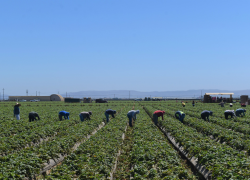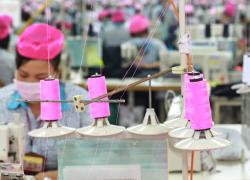
According to the International Labor Organization, 28 million people around the world are trapped in forced labor. Some are compelled to work in dangerous conditions. Many are isolated, held in debt bondage, threatened, or have their passports and documents confiscated, making it nearly impossible to seek help or flee. Many become victims of trafficking because they are in desperate need of economic opportunities or trying to escape difficult life circumstances.
Where is this happening?
In nearly every country and in the supply chains of products and services you encounter daily. Here are three places where you should know that trafficking is occurring.
Palm oil plantations
If you have shopped at a grocery store, chances are you have bought something containing palm oil. Palm oil is an ingredient in countless products we use daily, from makeup and shampoo to baked goods and cooking oils. Palm oil comes from the fruit of the oil palm tree, 85% of which is harvested in Malaysia and Indonesia. Workers on palm plantations, many of whom are migrant workers lured by the false promises of good jobs, are often vulnerable to child labor and forced labor. Children and adults are subjected to dangerous working conditions, sexual violence and excessive work hours to meet steep work quotas. Palm oil from this part of the world – along with the myriad of products made with palm oil – is shipped globally to destinations including China, India and the U.S.
The U.S. Department of Labor is raising awareness about the risk of child labor and forced labor in the supply chains of products containing palm oil. Our latest List of Goods Produced by Child Labor or Forced Labor warns of multiple palm oil products that contain ingredients tainted by labor exploitation, and we’ve made recommendations to both governments and the private sector on how to address these abuses.
Southeast Asia scam call centers
Nearly everyone with a cell phone has received a scam call or text. A friendly voice on the line asks you about your day and begins to pitch you a false investing opportunity, a bogus extended car warranty or a fake trial of a new computer virus protection service. You might not know that these calls and texts are increasingly coming from people in forced labor in Southeast Asia.
There are growing reports of workers from Thailand, Taiwan, Vietnam and Indonesia, among others, who are promised good jobs by unscrupulous recruiters, only to find themselves trapped in forced labor in makeshift call centers that are heavily guarded. Their passports are confiscated, and they are forced to work long hours and meet daily targets for successful scams. There are even reports of workers being moved or traded among other illegal call centers in the region.
The U.S. Department of Labor is continuing to monitor these situations in order to more effectively engage with the governments of countries in which such fraud is escalating.
Climate-related trafficking
Wildfires, severe flooding, droughts and heatwaves – the effects of climate change – are increasingly in the headlines. A lesser-known effect of climate change is its connection to human trafficking. When people are forced to leave their homes and abandon their livelihoods as a result of changing weather patterns brought on by climate change, they become more vulnerable to traffickers’ false promises of good jobs.
The Intergovernmental Panel on Climate Change estimates that 3.3 to 3.6 billion people live in contexts that are highly vulnerable to climate change. They are susceptible to water scarcity, crop loss, infectious disease, malnutrition and damage to infrastructure, all of which can drive migration. The World Bank reports that without urgent climate action, 140 million people in Sub-Saharan Africa, South Asia and Latin America could become climate refugees within their own countries by 2050. This would increase the risk of human trafficking.
For many, this is already a reality. The 2022 UN Global Report on Trafficking in Persons noted increases in human trafficking after typhoons in the Philippines, as well as high rates of forced labor in an area of Bangladesh prone to cyclones that have damaged crops and increased poverty.
This is an emerging area of research and programming for our Office of Child Labor, Forced Labor, and Human Trafficking. The Biden-Harris administration is also taking action on climate change, in part by bolstering global climate resilience and accelerating global climate action.
The prevalence of forced labor in 2023 is deeply unsettling. Governments need to strengthen legal protections and step up enforcement efforts, and companies need to do more intensive due diligence to clean their supply chains. Strong, independent, democratic unions and support for the right to collective bargaining make it much harder for forced labor to flourish. You can do your part by becoming informed, holding your elected officials accountable and asking the companies you buy from to support fundamental labor rights throughout their supply chains. We must all work together to end this scourge.
Thea Mei Lee is the deputy undersecretary for international affairs. Follow the Bureau of International Labor Affairs on Twitter at @ILAB_DOL.

 U.S. Department of Labor Blog
U.S. Department of Labor Blog


